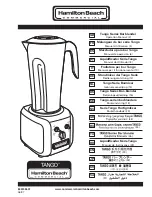
15
INTELLIGATE XR2000
THRESHOLD control
Now adjust the THRESHOLD control anticlockwise, until the softest hit on the percussion instrument triggers
the Expander so that the desired signal will pass unaffected. Triggering of the Expander will be monitored by
the flash of the ABOVE LED. If you have correctly adjusted the unit, you will hear the instrument clearly stand
out from the programme material.
ATTACK control
Most instruments are characterized by their typical initial profile. For example, instruments like piano, guitar,
cymbals etc. are recognized by their short attack and particulary long release time.
Increasing the attack time changes the envelope, especially on percussive instruments, whereby hard sounds
generally become softer.
Special attention should be paid to fast attack times! Especially with low frequency signals, such as bass
drum and bass guitar etc. Extreme fast attack times can lead to switching noise (“clicks”). This effect will not
be produced by the control feedthrough of the INTELLIGATE, but by the abrupt cut into the signal’s waveform
above or below the zero crossing point. A slight prolongation of the attack time or a decrease in the ratio will
help you to avoid this side effect.
HOLD control
Programme material (e.g. speech or vocal recordings) often contains short pauses which can lead to continuous
triggering of the expander. The hold function prevents premature shutdown which is a problem with conventional
gates, by delaying the release process. The result is, that the expander remains active during these short
pauses. After the period of the adjusted hold time, the expander closes the audio channel dependent on the
release function.
RELEASE control
Most percussion instruments have a longer decay time (e.g. the decay of cymbals). By adjusting the release
time, this function offers the ability to follow the fade out of the instrument, in order to maintain the entire
character of the sound. In this way you can prevent a too short release time from affecting the natural decay
and the additional ambient sound of the instrument.
For signals with long durations or signals with heavy ambience, it is advantageous, to choose long release
times. You will find, that a fast release time is more preferable for accustic separation of most percussive
sounds, whilst cymbals and tom toms normally benefit from slower release times.
If the controls are set correctly, the drum sounds will be “dry”, “sharp” and clearly defined.
RANGE control
The RANGE control defines the amount of maximum attenuation of the audio signal. For instruments with
longer decay times, it is advantageous to adjust the RANGE control to a mid position, in order not to cut off the
signal completely. Although the INTELLIGATE allows for a maximum attenuation of 100 dB, generally it is not
useful to attenuate a signal by this value. With noisy signals in particular, it is recommended to limit the
attenuation by a value of 10 to 20 dB, in order not to let the onset of the expander become too noticeable.
3.1.2 The EXPANDER function
In contrast to the gate function, the expander function is based on gradual attenuation, as soon as the signal
falls below the threshold level.
RATIO control
With this control, you determine whether the INTELLIGATE functions as a gate or an expander. If for instance,
a music programme has been heavily compressed during recording, the lost dynamics can be subsequently
restored by a complimentary expansion. With some “finger-tip-feeling”, the following controls can be adjusted
by ear, so that original dynamics can be restored.
It is recommended to adjust the RATIO control to values of about 1.2:1 to 1.6:1 in order to achieve a gentle
expansion and to adjust the THRESHOLD control, so, that the entire dynamic range of the music lies below
the threshold. Adjust the THRESHOLD control in this manner, so that only the loudest passages exceed the
threshold. This can be monitored by the flashing ABOVE LED. This will now result in a downward expansion,
which is only restricted by the adjustment of the RANGE control. It is recommended to adjust the RANGE
control to values of about 20 to 30 dB.
3. APPLICATIONS












































